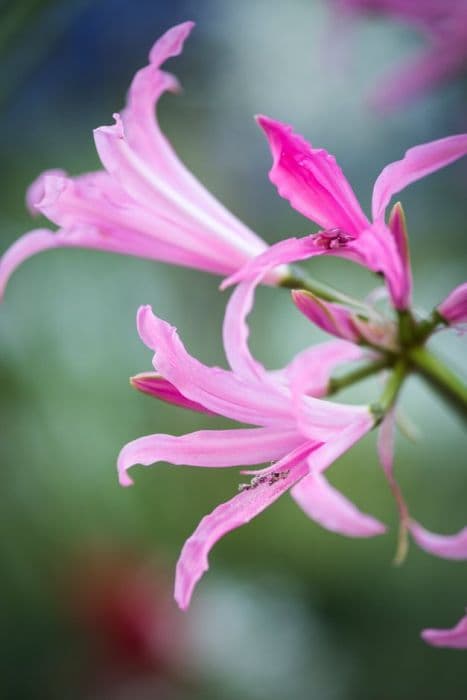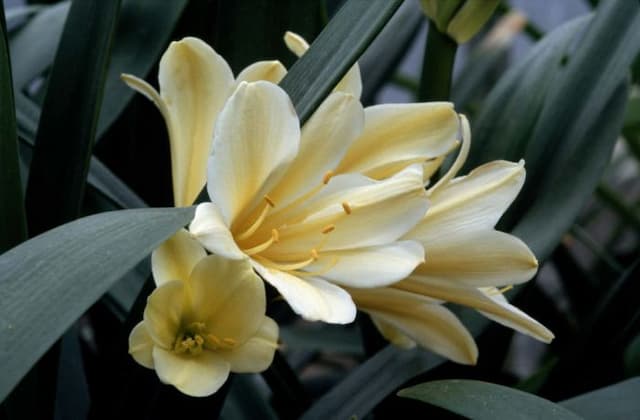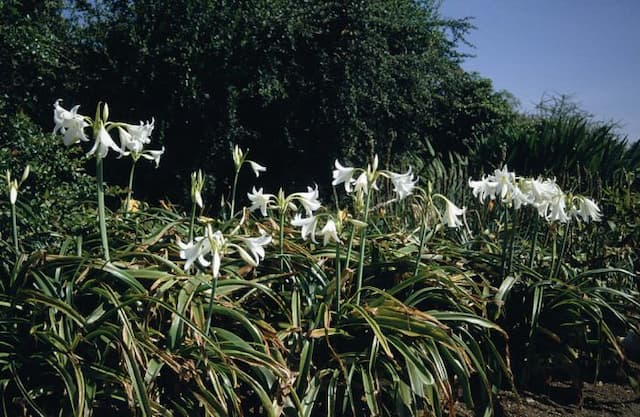Snowdrop Galanthus 'Straffan'

ABOUT
Galanthus 'Straffan' is a perennial plant more commonly known as a variety of snowdrop. This plant features delicate nodding white flowers that are quite distinctive, each one comprising three outer petals that are pure white and generally longer, enveloping smaller, inner petals which usually have green markings. These inner petals are unique due to their green-tipped or green-spotted patterns, giving the snowdrop its characteristic charm. The foliage of Galanthus 'Straffan' is also worth noting, with slender, strap-shaped leaves that are a fresh, bright green color. These leaves form a tuft from which the flower stalks emerge, each carrying a single bloom. The leaves provide a pleasing contrast to the brilliant white of the flower. The snowdrop blooms during late winter to early spring, often emerging through the snow in regions with colder climates, providing an early sign of spring. The snowdrop is admired for its demure appearance and for its resilience, often being one of the first flowering bulbs to announce the end of winter.
About this plant
 Names
NamesFamily
Amaryllidaceae
Synonyms
Straffan Snowdrop, Straffan Galanthus
Common names
Galanthus 'Straffan'
 Toxicity
ToxicityTo humans
The common name for Galanthus 'Straffan' is snowdrop. Snowdrops contain alkaloids, including galantamine, which can be toxic if ingested by humans. The symptoms of snowdrop poisoning may include gastrointestinal discomfort such as nausea, vomiting, and diarrhea. In severe cases, ingestion can lead to more serious effects such as low blood pressure, dizziness, and irregular heartbeats. Handling the plant may also cause skin irritation in some individuals. It is important to avoid consuming any part of the snowdrop plant.
To pets
Snowdrop is the common name for Galanthus 'Straffan' when discussing pets. This plant is similarly toxic to pets, including dogs and cats, as it is to humans. If a pet ingests snowdrop, they can experience symptoms such as vomiting, diarrhea, abdominal pain, and lethargy. In more severe cases, ingestion could cause cardiac arrhythmias or neurological symptoms due to the alkaloids present in the plant, particularly galantamine. Care should be taken to prevent pets from consuming any part of the snowdrop plant.
 Characteristics
CharacteristicsLife cycle
Perennials
Foliage type
Deciduous
Color of leaves
Green
Flower color
White
Height
6-12 inches (15-30 cm)
Spread
3-6 inches (7.5-15 cm)
Plant type
Bulb
Hardiness zones
3-7
Native area
Europe
Benefits
 General Benefits
General Benefits- Early Blooming: Galanthus 'Straffan', commonly known as Snowdrop, typically flowers in late winter or early spring, providing an early source of nectar for pollinators.
- Aesthetic Appeal: With its delicate white flowers, Snowdrop can add beauty to winter gardens when most other plants are dormant.
- Low Maintenance: Snowdrop is known for being easy to grow and requiring minimal care once established.
- Naturalizing: Snowdrop bulbs can spread and naturalize in an area over time, forming attractive clumps.
- Cold Tolerance: Well-suited for cold climates, Snowdrops can withstand frost and snow cover.
- Ground Cover: When planted in groups, Snowdrops can provide ground cover, helping to protect soil structure and suppress weeds.
- Wildlife Support: They provide an early food source for bees and other pollinators emerging in late winter.
- Resilience: Snowdrops are resistant to most pests and diseases, making them a hardy choice for gardens.
- Versatility: Suitable for planting in a variety of settings including borders, rock gardens, and woodland gardens.
- Harbinger of Spring: Their blooming is often seen as a sign that spring is on its way, lifting spirits after the winter months.
 Medical Properties
Medical PropertiesThis plant is not used for medical purposes.
 Air-purifying Qualities
Air-purifying QualitiesThis plant is not specifically known for air purifying qualities.
 Other Uses
Other Uses- Galanthus 'Straffan', commonly known as snowdrop, can be used as a natural pest deterrent due to its release of a subtle scent that many pests find unappealing.
- They can be floated in glass bowls as a delicate and unique indoor decoration during their blooming season.
- Their bulbs can be used in "lasagna planting" or layered bulb pots to create staggered blooms in a container garden.
- As an early bloomer, snowdrops can be a food source for bees and other pollinators when few other flowers are available.
- Their presence can indicate the health of an ecosystem, serving as bioindicators for scientists studying climate change and habitat integrity.
- Snowdrops can be used in a winter wedding bouquet or centerpieces as a symbol of hope and the coming spring.
- They can be part of a moon garden, where they will reflect the moonlight with their bright white flowers during nighttime.
- Snowdrops are sometimes dried and pressed to be used in crafting, such as in making bookmarks or paper decorations.
- They can be used in literary and artistic inspiration, often featuring in poems and artworks due to their delicate beauty.
- Snowdrops' emergence can be used by educators to teach concepts of plant life cycles and early spring phenology.
Interesting Facts
 Feng Shui
Feng ShuiThe Snowdrop is not used in Feng Shui practice.
 Zodiac Sign Compitability
Zodiac Sign CompitabilityThe Snowdrop is not used in astrology practice.
 Plant Symbolism
Plant Symbolism- Purity: The snow-white color of the Galanthus, commonly known as Snowdrop, often symbolizes purity and innocence.
- Hope: Emerging often while snow still covers the ground, Snowdrops represent hope and the arrival of spring.
- Consolation or Comfort: Due to their early blooming, Snowdrops can also signify consolation or comfort during difficult times, suggesting that better times are ahead.
- Renewal: As one of the first flowers to bloom at the end of winter, Snowdrops symbolize renewal and the cycle of life.
- New Beginnings: They are often seen as a sign of new beginnings, as they indicate the forthcoming spring and the end of winter.
 Water
WaterSnowdrops, which is the common name for Galanthus 'Straffan', prefer to be watered moderately. During the active growing season, water them when the top inch of soil feels dry, which may be once a week, with about 1-2 gallons per square yard, depending on the soil's ability to retain moisture and the weather conditions. Once established, snowdrops are fairly drought-tolerant but should not be allowed to dry out completely. During dormancy, in the late spring and summer, watering can be reduced significantly as the bulbs are resting.
 Light
LightSnowdrops thrive in dappled sunlight to partial shade conditions. The ideal spot for them is under deciduous trees or shrubs where they can receive filtered sunlight in the spring before the trees fully leaf out. They can also tolerate full sun in cooler climates, but the soil must remain moist.
 Temperature
TemperatureSnowdrops are hardy and do well in a range of temperatures but ideally prefer a cooler climate, thriving in temperatures between 35°F and 53°F. They can survive winter temperatures down to -20°F and should be planted in an area where they are not subjected to extreme heat, as conditions above 77°F can be detrimental to the bulbs.
 Pruning
PruningPruning snowdrops is typically not necessary, as they are low-maintenance plants. The foliage should be allowed to die back naturally after flowering to provide energy for the bulb for next year's growth. If any leaves or flowers become damaged or diseased, they can be removed at any time to maintain plant health.
 Cleaning
CleaningAs needed
 Soil
SoilSnowdrops prefer well-drained soil rich in organic matter with a pH of 6.5-7.0. A mix of garden soil, peat moss, and perlite would create an ideal environment for Galanthus 'Straffan'.
 Repotting
RepottingSnowdrops, such as Galanthus 'Straffan', are perennial bulbs and do not require frequent repotting. They can be left undisturbed for several years unless they become overcrowded.
 Humidity & Misting
Humidity & MistingSnowdrops like Galanthus 'Straffan' are tolerant of a wide range of humidity levels but thrive best when outdoor humidity is naturally present in a temperate climate.
 Suitable locations
Suitable locationsIndoor
Position snowdrops in cool, bright area, away from direct heat.
Outdoor
Plant in dappled shade, moist, fertile soil; divide clumps after blooming.
Hardiness zone
3-7 USDA
 Life cycle
Life cycleGalanthus 'Straffan', commonly known as the 'Straffan' snowdrop, starts its life cycle when the underground bulb, which contains stored nutrients, enters a period of dormancy during the summer months. As temperatures cool and winter approaches, the bulb breaks dormancy and begins to sprout, usually around late winter to early spring. The plant emerges through the soil, exhibiting thin, linear leaves and a singular flower stalk, bearing a nodding, white, bell-shaped flower, often with a characteristic green mark on its inner petals. After pollination, typically by bees attracted to its mild fragrance, the plant will produce a capsule containing seeds. Once the seeds are dispersed, often by ants attracted to the elaiosome (a fleshy structure attached to the seed), the snowdrop's foliage will die back and the bulb will re-enter a period of dormancy until the next cycle. This cycle of growth, flowering, seed production, and dormancy repeats annually.
 Propogation
PropogationPropogation time
Early Spring
Propogation: Snowdrops, including the Galanthus 'Straffan', are typically propagated through the division of their bulb offsets, often referred to as "twin scaling". The best time to propagate them by division is when the plants are dormant, usually from late spring to early summer after the foliage has died back. In twin scaling, a mature bulb is carefully separated into sections, each with a portion of the basal plate (the bottom part of the bulb from which roots grow) and at least one scale attached. These sections are then typically treated with a fungicide and placed in a moist growing medium at a warm temperature to encourage the development of new bulblets. Over time, these bulblets will grow into flowering-size bulbs, although this process can take a couple of years. The precise approach to twin scaling requires a degree of care and cleanliness to avoid disease and ensure the best chances of successful propagation. This method is popular among gardeners aiming to increase their snowdrop collection or share these beloved spring flowers with others.









